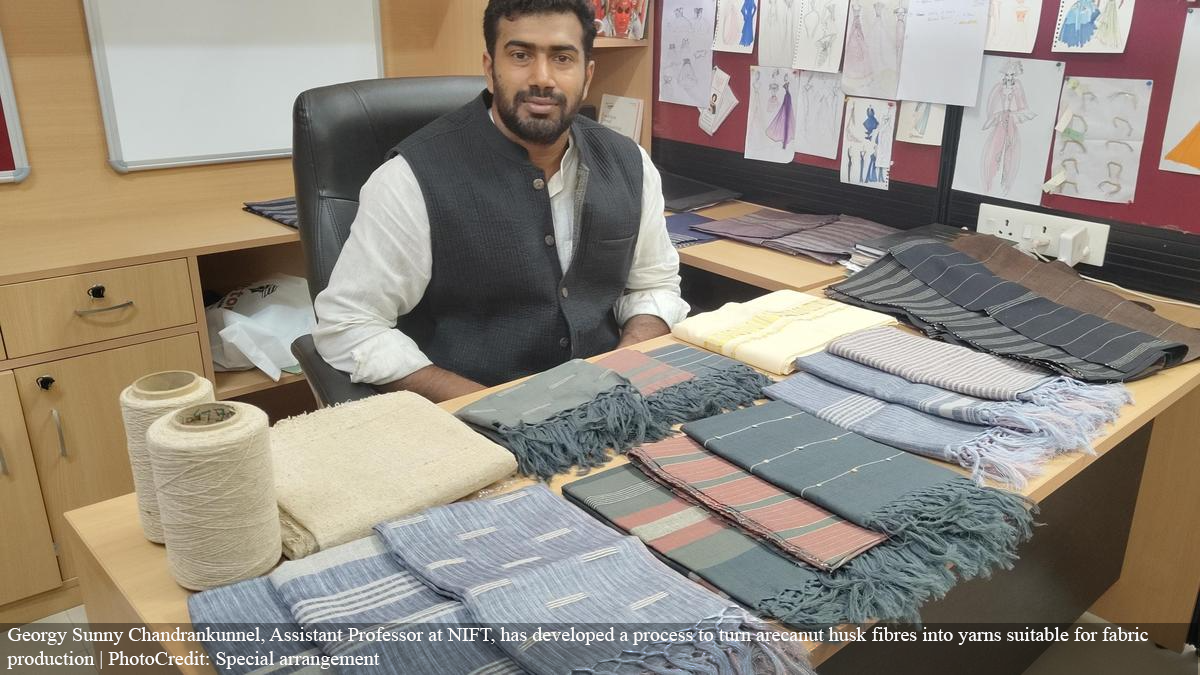
Category: FIBRES
Country: India
Region: Asia
By C P Sajit
27th October 27, 2024 06:48 pm IST
Updated 07:09 pm IST - KANNUR
Areca nut farmers in Kerala, who have long struggled with disposing of large amounts of areca nut husk, may now have a promising solution. This agricultural byproduct, often discarded or burned, is now being transformed into a valuable raw material for the textile industry, thanks to the pioneering work of a researcher at the National Institute of Fashion Technology (NIFT) in Kannur. Georgy Sunny Chandrankunnel, Assistant Professor at NIFT, has developed a process to turn areca nut husk fibres into yarns suitable for fabric production.
Mr. Georgy’s research, initially sparked by his childhood experiences on his family’s ancestral areca nut farm in Balal, Kasaragod, has evolved into an endeavour in a sustainable fashion. “The possibilities I saw as a young boy on our farm laid the foundation for my interest in sustainable textile practices,” he reflects. “It’s an honour to contribute something back to the community I grew up in, using materials we never thought had much value.”
The research not only taps into sustainable solutions but also offers a meaningful economic prospect for farmers. Areca nut husks, previously disposed of through burning — a method linked to respiratory illnesses and environmental degradation — can now be redirected towards textile production. The fibre extracted through a water retting process yields a natural golden-yellow hue, adding a unique aesthetic value to the fabric.
“My primary objective was to convert agricultural waste into something that aligns with contemporary fashion trends while helping farmers,” he explains. “The initiative paves the way for them to sell areca nut shells directly to the textile industry, creating an alternative income stream.”
The research has progressively refined the fibre extraction process, leading to softer and more versatile areca nut fibres that comprise up to 90% of his yarn blends. “Initially, I could only achieve a thick yarn combining areca nut with cotton, but as the process improved, I could produce finer yarns,” he said. “This not only allows for more applications but also integrates the natural beauty of the fibres into the final product.”
Mr. Georgy has also come out with a design collection titled “Memory of Malabar,” capturing his vision of sustainable innovation rooted in local heritage. Inspired by the lush landscapes and traditional architecture of Kerala’s Malabar coast, the collection features scarves, curtain fabrics, and a reimagined version of the Kerala dhoti, where areca nut yarn takes the place of traditional golden zari.
Mr. Georgy recently presented his collection at IDEAS-2024, an international symposium hosted by IIT Roorkee and Queen’s University, Canada, which focused on “Innovation through Design and Co-Creation in Resource-Constrained Society.” The event brought together innovators and scholars from across the globe to discuss solutions aligned with the United Nations Sustainable Development Goals.
“For me, this isn’t just research. It’s about honouring my roots while creating something meaningful for future generations,” he adds.
Courtesy: The Hindu
Copyrights © 2025 GLOBAL TEXTILE SOURCE. All rights reserved.